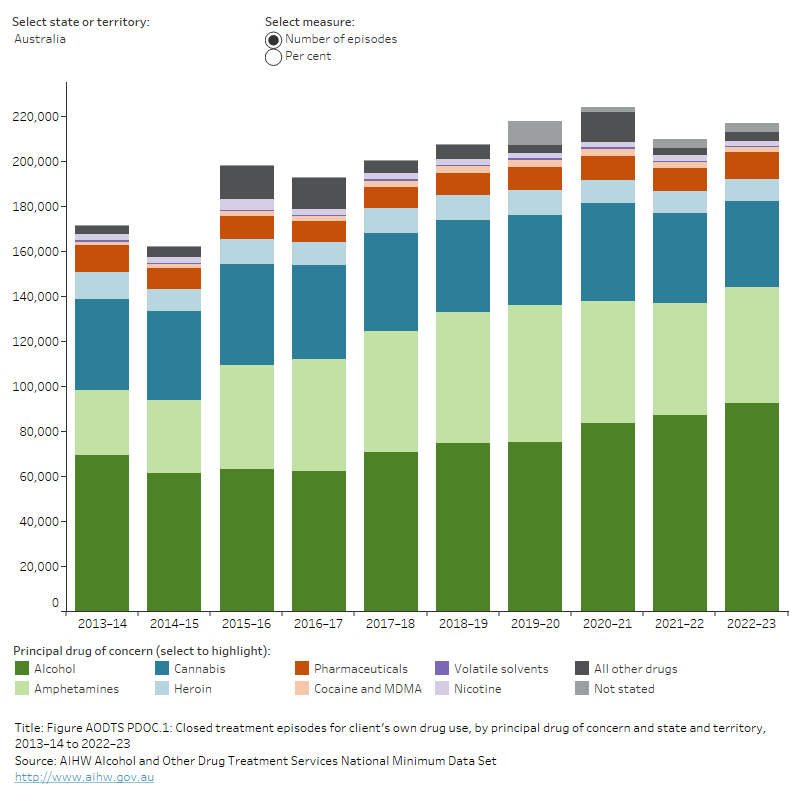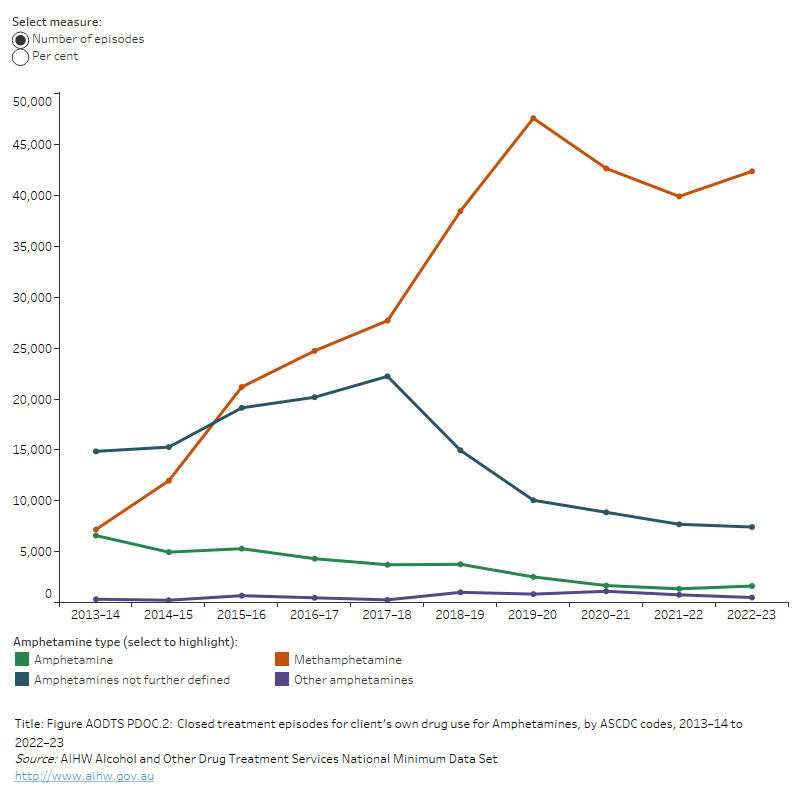Drugs of concern
What drugs do people seek treatment for?
Clients of alcohol and other drug (AOD) treatment services include people who are seeking treatment for their own drug use, and those seeking assistance for someone else’s drug use. Most people have one drug that is of greater concern for them, and their treatment will typically focus on this drug – this is referred to as the principal drug of concern. Clients who use more than one drug can also report additional drugs of concern.
Principal drug of concern
The most common principal drug of concern that led people to seek treatment was alcohol.
For people who received treatment for their own alcohol or drug use in 2022–23:
- Over 2 in 5 (43%) treatment episodes were for alcohol, followed by amphetamines (24%), cannabis (17%) and heroin (4.5%). This pattern was similar for both males and females, and Aboriginal and Torres Strait Islander (First Nations) clients (Figure AODTS PDOC.1).
- Where amphetamines (51,902 episodes) were reported as the principal drug of concern, over 4 in 5 (82%) treatment episodes were for methamphetamine.
For clients, there was variation across age groups for the most common principal drugs of concern:
- Alcohol was the most common principal drug of concern for older clients (48% of those aged 40–49; 63% of those aged 50–59; and 77% of people aged 60 and over).
- Amphetamines were the most common principal drug of concern for clients aged in their 20s and 30s accounting for 1 in 3 clients aged 30–39 (32%) and 1 in 4 aged 20–29 (25%).
- Cannabis was the most common principal drug of concern for younger clients, with almost 2 in 3 (64%) clients aged 10–19 receiving treatment for cannabis.
Figure AODTS PDOC.1: Closed treatment episodes for client’s own drug use, by principal drug of concern and state and territory, 2013–14 to 2022–23
The stacked bar graph shows the closed treatment episodes for clients’ own drug use by principal drug of concern and state and territory, from 2013–14 to 2022–23. Between 2013–14 and 2022–23, the number of treatment episodes increased from 171,828 episodes in 2013–14 to 217,303 episodes in 2022–23.
The four most common drugs of concern have remained consistent through this period. In 2022–23, 92,417 (42.5%) of closed treatment episodes had alcohol as the principal drug of concern (increasing from 69,491; 40.4% in 2013–14); 51,902 (23.9%) of episodes had amphetamines (increasing from from 28,919; 16.8% in 2013–14); 37,969 (17.5%) of episodes had cannabis (increasing from 40,505; 23.6% in 2013–14); and 9,745 (4.5%) had heroin (falling from 12,000; 7.0% in 2013–14).

Notes:
- South Australia reports a high proportion of treatment episodes where amphetamines are the principal drug of concern due to the SA Police Drug Diversion Initiative (PDDI). In addition, adult cannabis offences are not included in the PDDI due to the SA Cannabis Expiation Notice legislation.
- In Queensland, the level of cannabis reported as the principal drug of concern is a result of the police and illicit drug court diversion programs operating in the state.
- Victoria reported relatively high incidences of ‘All other drugs’ due to service provider reporting practices and limitations with the data reporting system. This system was replaced in 2019–20. In 2019–20 and 2020–21, Victoria continued to report high levels of miscellaneous episodes coded as ‘Other drugs’ or ‘Not stated’ as principal drugs of concern due to service provider reporting practices with the new data reporting system.
- In the Australian Capital Territory (ACT), data collection improvements at government-operated services resulted in fewer ‘Not stated’ responses in the 2022–23 collection. Removal of criminal penalties for possession of small quantities of cannabis in the ACT at the end of January 2020 reduced the number of cannabis-related diversions recorded as treatment episodes to low levels (mainly under-18s). One large ACT program discontinued reporting in the second half of 2022–23 which may influence trend comparisons.
- Pharmaceuticals include codeine, morphine, buprenorphine, oxycodone, methadone, benzodiazepines, steroids, other opioids, other analgesics, and other sedatives and hypnotics.
- The AODTS NMDS also collects data on a client's additional drugs of concern, but this variable is not included in these data visualisations.
- Data are subject to minor revisions over time.
- Components of tables may not sum to totals due to rounding.
Methamphetamine
Methamphetamine as a principal drug of concern (coded within amphetamines) has been relatively stable, accounting for around 4 in 5 amphetamine-related treatment episodes over the past 3 years. In 2022–23, methamphetamine accounted for 82% of episodes (42,380 episodes) within the amphetamines category (Figure AODTS PDOC.2).
Over the last 10 years, treatment episodes for amphetamines and amphetamines not further defined (nfd) decreased as coding practices improved in reporting treatment for methamphetamine. The rise in reported episodes for methamphetamine can be attributed to a range of factors including improvements in agency coding, treatment system updates and increases in funded treatment services.
Figure AODTS PDOC.2: Closed treatment episodes for client’s own drug use for Amphetamines, by (ASCDC) codes, 2013–14 to 2022–23
The line graph shows that, among closed treatment episodes for client’s own drug use for amphetamines, methamphetamines have been the most common drug of concern since 2013–14. In 2022–23, there were 42,380 (81.7%) episodes with methamphetamines as a principal drug of concern, a large increase from 7,168 (24.8%) episodes in 2013-14.
The number and proportion of episodes with amphetamines not further defined has fallen from 14,853 episodes (51.4%) in 2013–14 to 7,419 episodes (14.3%) in 2022–23. The number and proportion of episodes with amphetamine has fallen from 6,579 episodes (22.7%) in 2013–14 and to 1,615 episodes (3.1%) in 2022–23.
The number and proportion of episodes with other amphetamines has fluctuated over the years with 319 episodes in 2013–14 (1.1%) and 488 episodes in 2022–23 (0.9%).

Notes:
- 'Other amphetamines' include amphetamine analogues, dexamphetamine and amphetamines not elsewhere classified from the Australian Standard Classification of Drugs of Concern (ASCDC).
- Amphetamines nfd are amphetamines not further defined.
- There were jurisdictional improvements to coding methamphetamine from 2014–15 onwards.
- The AODTS NMDS also collects data on a client's additional drugs of concern, but this variable is not included in these data visualisations.
- Data are subject to minor revisions over time.
- Components of tables may not sum to totals due to rounding.


